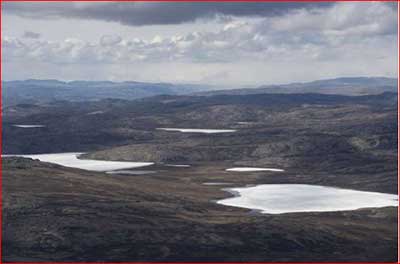Date: 12/12/2022
Relevance: GS-3: Conservation, environmental pollution and degradation, environmental impact assessment
Key Phrases: The Arctic, Climate Change, Arctic Warming, Winter Warm Events, Savoonga Creek, Arctic amplification.
Why in News?
- Recently Utqiagvik, Alaska's northernmost community formerly known as Barrow has recently hit 40 degrees (4.4 degrees Celsius).
- As per a research report from the International Arctic Research Center, it is the warmest that the region has seen on a record from late October to late April.
Key Highlights:
- Savoonga Creek was flooded and snow cover was absent, snow was also absent in the town of Teller northwest of Nome, where snow this time of year is used for drinking water.
- The Arctic as a whole averaged 11.5 degrees (6.4 degrees Celsius) warmer than the 1979-2000 average temperature
- Sea ice in the Arctic is about the sixth lowest on record, according to the National Snow and Ice Data Center.
- Sea ice matters because in areas of the Arctic there is no sun in the winter and the atmosphere is cold but if there is open water, then it is usually warmer than the atmosphere.

Reasons for the warming of the Arctic:
- The Arctic amplification:
- It is a phenomenon where the Arctic warms up faster than the rest of the planet due to temperature differences in the poles.
- Amplification occurs when, White Sea ice thins or disappears, allowing dark ocean or land surfaces to absorb more heat from the sun and release that energy back into the atmosphere
- Part of it is because of a system of storms, which is likely just random weather, but part is from lower than normal ice, which is human-caused climate change.
Impact of Arctic warming on the world:
- Temperatures:
- The Arctic and Antarctic are covered in white snow and ice that reflect heat back into space and balance out other parts of the world that absorb heat.
- Less ice means more extreme winters as the Polar jet stream, a high-pressure wind that circles the Arctic region is destabilized by warmer air which can dip south, bringing the bitter cold with it.
- Food security: Polar vortexes, increased heat waves, and unpredictability of weather caused by ice loss are already causing food insecurity and hunger.
- Shipping: As ice melts, new shipping routes open up in the Arctic. These routes will be tempting time-savers, but will be incredibly dangerous.
- Permafrost: Arctic ice and permafrost—ground that is permanently frozen store large amounts of methane, a greenhouse gas that contributes to climate change. When it thaws, that methane is released, increasing the rate of warming.
- Wildlife: Loss of ice and melting permafrost spell trouble for polar bears, walruses, arctic foxes, snowy owls, reindeer, and many other species. As they are affected, so too are the other species that depend on them, in addition to people.
Impact on India:
- The State of the Global Climate, a report from the World Meteorological Organisation (WMO), indicates that sea levels are rising faster than average along almost the entire Indian coast.
- The levels have risen despite the occurrence of the La Niña phenomenon – where rainfall is diverted to land, thereby lowering the sea level.
- Images from NASA, show that sea levels have been rising in the Sunderbans delta for the past 20 years at the rate of 30 mm per year, with a 12% loss in the shoreline.
- This is more than six times the average level for the world, and it has already resulted in the eviction of about 1.5 million residents of the delta.
- The rise in sea levels and intense cyclones will make places like the Sundarbans uninhabitable.
Way Forward:
- Limiting the increase in global temperature is our best chance of securing a safer future for all.
- By keeping the rise to 1.5 C we can prevent the worst effects of climate change but helping communities and wildlife adapt to changes already underway in the meantime is essential.
Conclusion:
- To deliver on these important goals, international and domestic forums must work with local communities, governments and others around the world.
- This can significantly and quickly reduce emissions and help people and nature prepare for the many impacts of a changing climate. For example, WWF is testing new on-the-ground projects to help at-risk species and local communities adapt.
Source: The Hindu
Mains Question:
Q. Critically analyze the impact of reducing snow cover in Arctic region in context with India. (150 words).






















